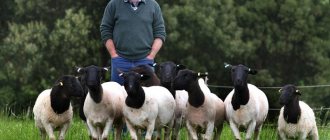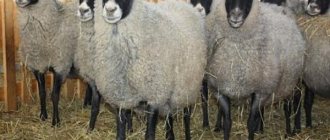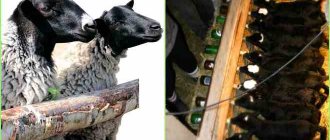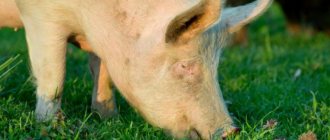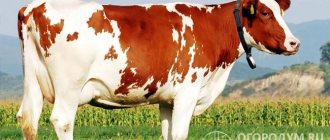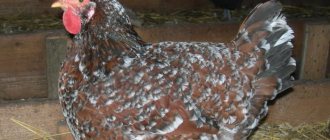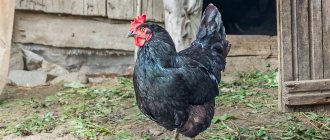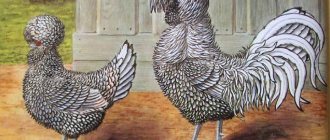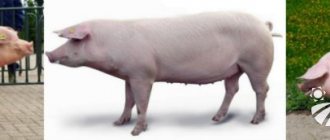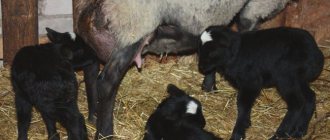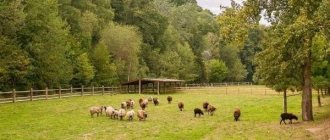The Edilbaevskaya breed of sheep was bred in the 19th century in the Russian Empire (in the territory of present-day Kazakhstan) by crossing Kazakh fat-tailed sheep with coarse-wool rams from the Astrakhan province. Kazakh livestock breeders needed a breed that could withstand all the rigors of steppe weather conditions - both drought and cold winters and frosts. She also had to be capable of long journeys over long distances, while eating very meager pasture in these parts and gaining weight.
Edilbaevskaya breed of sheep
From the individuals obtained through such crossing, the healthiest and largest were subsequently selected. As a result of the selection carried out in this way, the Edilbaevsky breed was obtained, which is distinguished by its extreme unpretentiousness in maintenance, high levels of endurance and incredible meat productivity, but at the same time it is not very fertile and has hard wool, the average annual clip of which can nevertheless be up to 5 kg.
Edilbaevsky sheep
Description
Sheep of the Edilbaev breed are distinguished by their correct physique. They belong to the so-called fat-tailed sheep, that is, they have a tail - fat deposits near the tail (tail fat is highly valued among eastern peoples - it is widely used in cooking, and can also be used as a natural preservative for storing meat).
Sheep of the Edilbaev breed. The fat tail is clearly visible in the back of the body
Edilbaevsky sheep are polled (have no horns). They are also distinguished by their large mass - adult rams can weigh around 110 kg, and ewes - about 70 kg. They gain weight very quickly from birth - a lamb can gain about 100 g per day.
Sheep are characterized by their large mass and lack of horns
The height at the withers is approximately 80 cm, the girth at the sternum is about 100 cm, the oblique length of the body is about 80 cm. Sheep vary in color: there are black, red and brown individuals. It is believed that black sheep have the highest productivity rates. The length of the wool of Edilbaev sheep is up to 15 cm. Despite the fact that the breed has high yields of wool and milk, from which fermented milk products, butter and cheese are made, the main goal of breeding sheep of this breed is to produce meat, the yield of which is up to 55% from the total weight of the ram, and fat tail fat.
Edilbaevsky sheep with different colors
Productivity
Livestock breeders prefer this breed due to the large quantities of wool, milk, meat and fat tail it produces. Fat tail is an animal fat that is used in cooking, cosmetology, and is a natural preservative. The meat yield after slaughter can reach 60 percent of the total weight of the animal, the weight of the fat tail exceeds 5 kg, and the amount of internal fat reaches 1 kg. One animal can produce more than 4 kg of wool and 150 liters of milk.
Lambs at the age of 4 months can already be slaughtered for sale and for their own needs.
Animals aged 6 months have the highest meat value. Further raising of livestock for meat is not a profitable activity due to the low demand for meat from adult sheep.
The milking period is only 4 months. During this period, sheep produce a large amount of fatty dairy product, which can be used to make cheese, sour cream and cottage cheese. To make a profit you must have at least 15 heads of dairy sheep.
The main features of the coat of this breed are stiffness and heterogeneity. Despite these characteristics of wool, it is widely used for making carpets and winter clothing. Clothing made from sheep skin is in high demand among residents of the Kazakh steppes. Animals must be groomed every six months. This procedure will not only help to prepare the maximum amount of raw materials, but will also prevent skin diseases and the appearance of parasites.
Livestock breeders recommend paying special attention to the fat sac near the tail - the fat tail. This fat deposit contains a large amount of vitamins and nutrients.
It is widely used in cooking and also serves as a natural preservative.
Products
A five-month-old ram of the Edilbaev breed weighs 40 kg, of which 20 are meat carcass, and another 3 are fat tail weight. The corresponding figures for a seven-month-old ram are 23 kg and 4 kg. A one and a half year old ram weighs up to 70 kg, and its fat tail weighs 6 kg.
Ram of the Edilbaev breed
The mass of internal fat (interior fat, deposits around organs) reaches 800 g. The slaughter yield can be 55% of the animal’s weight. The average cut is on average 3-3.5 kg and can reach 5 kg. Sheep of this breed can produce 150 liters of milk.
The breed is distinguished by its great precocity - lambs show a large increase in weight day by day, and a four-month-old lamb is already completely ready for slaughter (4 months is the period when the weight of a lamb carcass meets all requirements). The greatest weight gain is observed at the age of 7 months.
Edilbaevskaya sheep with lambs
Nutrition
Despite all their resilience and unpretentiousness, Edilbaev sheep are genetically unable to digest forest hay, so it must be excluded from the diet when preparing it. The same applies to swamp hay, although some sources do not indicate it.
Sheep obtain most of their food on pastures, where they can eat almost any pasture. They must spend at least 200 days a year there. It is advisable that there is no rainy weather on the pasture at this time - Edilbaev sheep, like all others, do not digest food well that has been exposed to water. In addition, they have very sensitive hooves, and the animals can easily get sick.
Sheep in the pasture
On average, a sheep consumes 1.5-2 kg of hay and 0.5 kg of grain per day. To avoid diseases, it is strictly forbidden to feed rotten fruits to sheep. Additionally, animals should be fed with mineral supplements in the spring and root vegetables in the autumn. Be sure to add salt to your food.
Felucene salt lick with minerals for goats and sheep
Felucene prices
Felucene
In addition to pasture, a significant portion of the diet of Edilbaev sheep consists of special compound feed, as well as silage. The animal needs constant and continuous access to clean fresh water.
Sheep feed
Sheep feeding ration table
| Group of sheep | Diet |
| Newborn lambs (up to 5 days) | only mother's milk |
| Lambs up to 1 month | 50 g concentrated feed |
| Lambs up to 4 months | 300 g concentrated feed |
| Lambs 4-6 months | 0.5 kg of hay and vegetables, 300 g of feed, 150 g of cake, 4 g of salt |
| Young animals older than six months | 1 kg of hay, 500 g of vegetables, 200 g of feed, 8 g of salt |
| Ewes | 800 g of hay (of which 500 g is cereal, the rest is legumes), 3 kg of feed, 500 g of straw, 10-15 g of salt |
| Stud rams | 2 kg of hay, 3 kg of succulent feed, 600 g of concentrates |
| Sheep for fattening (before slaughter) | 700 g hay (quality), 5 kg silage, 900 g vegetables, 500 g concentrates |
Content
As already mentioned, Edilbaev sheep are very susceptible to dampness. Therefore, the shed where you are going to keep them must be dry. There should be no drafts in it, and it should be spacious, with large rows for paddocks.
Sheep room on a farm
Cleanliness of the premises is very important for the health of the animals. Make sure that there is no mold on the bedding where the sheep is placed. The room must maintain a constant temperature.
Sheep housing
Sheep hygiene must be monitored constantly. In the summer, they need to be bathed in water as often as possible using disinfectants to avoid infection with parasites. Hoofs should be cleaned and trimmed several times a year to prevent lameness.
Breeding
Sheep of the Edilbaev breed are not very fertile. The female is ready to give birth no more than twice a year, and, as a rule, she gives birth to only one lamb.
Sheep and lamb
Sexual maturity occurs at the age of 8 months, and for fertilization to occur, it is more likely that the ram needs to cover the ewe several times. Pregnancy lasts for 21 weeks, and the animal’s increased anxiety indicates its end date. At this point, it is better to prepare it - cut off the fur near the hole, replace the bedding and clean the room where it is located.
During the birth, the presence of a veterinarian is not necessary - most often it takes place without complications within forty minutes - but it is advisable, because sometimes a lamb can be born directly in the amniotic sac (in this case, it must be ruptured by a person as quickly as possible, otherwise the newborn may suffocate). Complications can also be caused by improper positioning of the lamb in the mother's womb. After birth, the lamb should be picked up, its nasal and oral openings cleaned of amniotic by-products and given to its mother, who herself will lick its wool and give her milk.
Sheep pregnancy
Reproduction
Mature sheep are fertilized by the end of spring. The duration of pregnancy for representatives of this breed is approximately 21 weeks. Labor activity occurs at the beginning of winter. Approximately 7 days before giving birth, a pregnant individual experiences changes in behavior, which is manifested by increased consumption of water and food or an almost complete refusal to eat.
Moreover, the female behaves restlessly and actively. A mature sheep can produce up to 3 young at a time, although more often there are no more than 2 lambs in one litter.
Advantages of the Edilbaevsky breed
Among the undeniable advantages of this breed are:
- unpretentiousness to weather conditions . Sheep can withstand any temperature changes and any precipitation conditions with equal resistance. The only thing sheep are not resistant to is wet soil because they have very vulnerable hooves. This can be solved by preventive measures to prevent the development of hoof diseases, as well as by preventing sheep from walking in wet weather.
- wide diet. There are at least about four hundred species of plants that Edilbaev sheep can feed on freely. They can digest small amounts of pasture with high efficiency, increasing their own mass day after day.
- high yield of products. This applies not only to meat and fat tail fat, for which this breed is mainly bred and for which it is so valued in Kazakhstan and the east in general, but also to wool (the Edilbaev breed has one of the highest yields of high quality wool, which grows quickly and is sheared off twice a year), as well as milk (the fat content of which ranges from 3 to 8%), from which fermented milk drinks (ayran), cheese (kurt) and butter are made in Kazakhstan.
- low cost of maintenance. Keeping Edilbaev sheep is extremely profitable because they do not require high-cost housing conditions and special care, while at the same time supplying a very large number of different products.
- large reserve of stamina. For steppe nomadic peoples, it is important that their sheep population can move with them over vast distances. Therefore, the Edilbaevskaya breed easily endures long hikes, while also gaining weight along the way due to pasture.
- heritability of traits. If there is a need to cross an Edilbaev sheep with some other sheep, then the resulting offspring has every chance of inheriting the positive characteristics of this breed. Most often they are crossed with the Romanov breed in order to neutralize one of the disadvantages of the breed - low fertility.
Edilbaevsky sheep are unpretentious
Origin story
The Edilbaevskaya breed of sheep appeared quite a long time ago - about 200 years ago. She was bred in Western Kazakhstan. The goal of the livestock breeders was to crossbreed the best fat-tailed sheep with coarse-wooled animals from Astrakhan farms.
Then, at the beginning of the 19th century, there were no farms in the Kazakh steppes - people who raised livestock wandered in search of new pastures. Therefore, the sheep also had to adapt to a nomadic lifestyle. This quality also appeared in representatives of the new breed.
The Edilbaevskaya breed of sheep appeared quite a long time ago - about 200 years ago.
As for the fat-tailed sheep, which were their ancestors, they were hardy animals that over the centuries managed to adapt to the sparse steppe vegetation, the scorching sun during the day and the extreme cold at night. In addition, drought in the steppe has always been a common occurrence, and resistance to such conditions was passed on to the descendants of these sheep. Despite the harsh steppe conditions, they build up fat - the same fat that is the main characteristic of fat-tailed animals (it is collected in a kind of pouch, and the older the animal, the more this reserve it has).
Disadvantages of the Edilbaevsky breed
There are not so many disadvantages, but they should be discussed briefly. Among them:
- low fertility of animals. It will take a significant amount of labor to multiply your livestock. The uterus is capable of bearing and giving birth to only one, or at best two, lambs per year;
- polled. The animal does not have horns, so it is fundamentally unable to defend itself from predators. The entire herd requires constant monitoring, because a sheep of this breed, having strayed from its relatives, is not able to independently find its way back;
- atrophying muscles. Since the breed is designed to be constantly on the move, a sedentary lifestyle can have a detrimental effect on its physical condition. Muscles that would develop normally under nomadic conditions begin to weaken with prolonged inactivity, which ultimately negatively affects the general condition of the animal;
- sensitivity to dampness. Vulnerable thin hooves do not allow sheep of this breed to walk on damp soil, because otherwise this can lead to both colds and diseases of the hooves themselves. Also, sheep cannot eat wet pasture, as it usually does after rainfall;
- hard and uneven coat. In the wool of the Edilbaev sheep, only a little more than 50% is fluff; the rest is awn (hard hair in the coat) and transitional hair. Dead hair is quite rare among sheep.
Sheep's wool is coarse and tough
A flock of Edilbaev sheep
Wool color
Traditionally, the wool of Edilbaevskaya sheep is black or of various red shades. But nowadays there are dark or light brown individuals. A distinctive feature of this variety of fat-tailed sheep is the relationship between productivity and the color of the coat. The weight of black and brown rams is approximately 5% higher when compared with individuals of other colors, and the level of milk yield is 10% higher.
Slaughter
The lamb must be slaughtered at the age of 5 months, because it is at this time that the peak of weight gain occurs. Further keeping the animal becomes less and less profitable, because the ratio of the cost of lamb feed and the price of its meat becomes less profitable; in addition, the meat of a five-month lamb is the most nutritious. A lamb carcass weighs from 15 to 20 kg. It is very important that slaughter is carried out in a short time - if there are delays between sending the lamb to slaughter, then it can lose a very significant amount of its weight (up to 7% in 24 hours).
To determine whether an animal is ready for slaughter, it is first weighed (weight should be 45 kg) and felt. If it has a rounded shape, the skin on the ridge rolls over, and the ribs cannot be felt through it, then it is quite possible to stuff it.
Ram slaughter
Milk
After lambing, a ewe can produce 120-180 liters of milk. At the same time, you can milk it for four months. This is a low indicator for sheep, therefore, in order for sheep breeding for the purpose of obtaining dairy products to become profitable, it is necessary to maintain a livestock of at least 20 queens. Sheep milk has a high fat content (up to 9%).
Straining sheep's milk is one of the stages of cheese making
Prices for milking machines for goats
Goat milking machine
Wool
Representatives of this breed are characterized by the presence of hard wool with a heterogeneous structure. Despite this, up to 3 kg of wool is obtained from one animal throughout the year. The wool obtained from such farm animals is used in sewing woolen clothing, making floor and wall carpets, etc.
Kurdyuk
In addition to meat, the fat sac at the tail of the animal - the so-called fat tail - is of significant value. The fat content in it reaches 14 kg in an adult sheep, and 4 kg in a lamb. Fat tail fat contains elements such as vitamins A, B and E, many minerals, phosphatides and fatty acids. Fat tail fat is a universal and widely used ingredient in the cuisine of Asia and the Middle East. It can also serve as a preservative for perishable meat products, which is especially important in hot climates.
Fat tail fat
Comparison with breeds of the closest quality
Edilbaevsky sheep belong to the meat and fat breed. This means that the main purpose of breeding sheep of this breed is to obtain meat products and fat tail fat, as well as internal lard. All other fat-tailed sheep belong to the same trend, including the Gissar breed and the Jaidara.
Gissar breed of sheep
The Gissar breed is the largest in the world. Accordingly, in terms of meat and fat indicators, they are slightly superior to Edilbaev sheep. However, their wool yield is significantly lower (1.2 kg versus 3), and the wool itself is even coarser and more heterogeneous. In addition, the cost of maintaining such sheep is significantly higher.
Jaidara is a breed that roughly corresponds to the Edilbaev breed in terms of meat, lard and fat yield, but is significantly inferior to it in terms of wool indicators (the content of dead hair in wool reaches 15%).
Jaidara is a fat-tailed breed of sheep that inhabits almost all regions of Uzbekistan
Wool products
This breed of agricultural cattle has thick and dense wool. Approximately 50% of wool is down, due to which it is characterized by excellent thermal insulation qualities. Edilbaev wool is an excellent raw material for making items needed in everyday life. In addition, it is used in industrial production.
On average, the length of the coat reaches from 10 to 15 cm. Whenever possible, the wool should be sheared; most often, sheep are sheared 1-2 times throughout the year, although experts recommend performing such a manipulation once every 10 months.
Results
The Edilbaevskaya breed of sheep produces a high yield of high-quality dietary meat products, a significant amount of fat tail and internal fat, coarse sheep wool used to create cloth and the formation of felt, sheep milk with a high fat content, as well as sheep skins used in tailoring.
Fresh sheep milk
Keeping this breed of sheep is very profitable, since the low cost of maintaining all the necessary structures is compensated by a large number of products in all directions. The meat yield from one sheep, for example, is equal to half of its total mass, which is a very good figure for sheep. In terms of the amount of wool, Edilbaev sheep completely surpass all other breeds from their direction. There is not a single indicator by which the product yield could be called insufficient.
Lamb is a very healthy meat
Keeping sheep will not be particularly difficult for a livestock breeder. Designed to withstand harsh climates, these animals are able to withstand any weather and any temperature. In terms of pasture, they are practically omnivores, which allows them to save a considerable amount of money on their food. The amount of food they should add to their diet is very small; These sheep have the remarkable ability to digest food well and quickly gain body weight from even a small amount of it.
Edilbaevsky sheep in the sheepfold
For camps, nothing beyond measure is also required - just a clean room with a normal temperature regime without drafts and bedding that is cleaned from time to time to prevent mold from growing in it. The only drawback is the hooves, which cannot withstand dampness and are prone to disease. Careful care for them will help solve this problem.
What does an overgrown hoof look like?
Hoof care tool
Thus, breeding sheep of the Edilbaev breed is completely economically justified. By acquiring a herd of at least twenty queens capable of producing milk, you can ensure a stable output of all the resources that can be obtained from keeping sheep, at perhaps the lowest price. The unpretentiousness of the breed will have a beneficial effect both on the amount of time that will need to be spent on caring for them, and on the money that you will spend on feeding them. All you need is a fairly wide pasture (the types of plants growing there do not really matter - only their presence) and suitable weather conditions (it is important to remember that frequent rains are detrimental to this breed, which is sensitive to dampness and requires frequent walking ).
Sheep pasture
There is great demand for all products obtained from Edilbaev sheep. Low-calorie meat from lambs aged 4-5 months contains a small amount of fat and is therefore often consumed when following certain diets. Fat tail fat, in addition to its traditional use in food, can be used for cosmetic purposes due to its high content of lanolin. High-fat milk serves as the basis for many other dairy products and can be consumed on its own. Coarse wool with no dead hair is used in the manufacture of industrial cloth.
Cloth cloth
This breed can rightfully be called universal. It is suitable for any conditions and for any purpose, be it slaughter for meat, milk production or wool shearing. Of course, in modern conditions it is not often that animals are required to be able to cross long distances, but even this, if the need suddenly arises, Edilbaev’s sheep are fully capable of doing this like no other. Perhaps their only significant drawback is poor fertility, but with the right approach to selection and crossing with other breeds, this problem can also be solved, since the genetic characteristics of the breed allow it to retain a significant part of its positive qualities.
Diseases and their treatment
Tick-borne encephalitis
Edilbaevsky sheep are susceptible to parasitic, infectious and non-contagious diseases.
The most common parasitic diseases are:
- Tick-borne encephalitis. Its causative agents are ticks. When infected, sheep develop a fever and develop a fever. After a few days, the symptoms disappear, and when the disease affects the brain, high fever appears again and problems with the nervous system arise. The disease ends in death, but if treatment is taken in time, the animal can be saved.
- Melophagosis. The Edilbaevets are susceptible to attacks by wingless flies, which deposit many eggs in the animal’s fur. With this disease, sheep tear their wool, severe exhaustion of the body is observed, milk yield decreases, and indigestion occurs.
- Helminthiasis. Infection with parasites is dangerous and can lead to loss of appetite, hair loss and internal hemorrhages.
The most dangerous are infectious diseases that can affect the entire herd, or a significant part of it:
- Listerosis. Nervous listerosis is especially dangerous. It is contagious, and no cure has been found. This disease is accompanied by edema, convulsions, lack of appetite, and paralysis. The disease ends in the death of animals.
- Smallpox. The disease has dangerous consequences and can lead to complications that lead to death. The disease manifests itself in the form of rashes, high fever, discharge from the mucous membranes, and conjunctivitis. A sick individual should be immediately isolated to avoid infecting its relatives. Age does not matter for smallpox. Both children and adults can become infected. The doctor prescribes antibiotics for treatment.
- Infectious mastitis. Appears due to improper maintenance and non-compliance with hygiene rules. In an advanced form of the disease in an animal, purulent discharge from the udder is added to the high temperature. The veterinarian prescribes antibiotics, and if inflammation occurs again, the udder is cut out.
Non-communicable diseases do not pose a threat to others, but can cause problems for animals.
Among them are:
- Rumen flatulence. This is a disease of the digestive system in which appetite disappears and anxiety appears. This is accompanied by severe bloating. The cause of flatulence is the cessation of the work of one of the scars, and this is caused by poor-quality food. To eliminate the disease, it is necessary to insert a tube through the animal’s mouth and use it to remove gases.
- Bezoar disease. The disease is characterized by animals eating their own fur. Lambs especially love to eat it. The danger of the situation is that the pieces of fur are not etched, but accumulate in the stomach. The disease cannot be cured.
- White muscle disease of lambs. It is caused by a lack of vitamins. Manifests itself in the form of weakness, cramps, heavy breathing, lameness, and swelling. The disease is incurable. To avoid problems, adults need to add a complex of minerals and vitamins to their diet.
